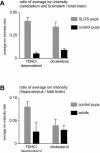Nanostructure-initiator mass spectrometry (NIMS) imaging of brain cholesterol metabolites in Smith-Lemli-Opitz syndrome
- PMID: 20670678
- PMCID: PMC2952448
- DOI: 10.1016/j.neuroscience.2010.07.038
Nanostructure-initiator mass spectrometry (NIMS) imaging of brain cholesterol metabolites in Smith-Lemli-Opitz syndrome
Abstract
Cholesterol is an essential component of cellular membranes that is required for normal lipid organization and cell signaling. While the mechanisms associated with maintaining cholesterol homeostasis in the plasma and peripheral tissues have been well studied, the role and regulation of cholesterol biosynthesis in normal brain function and development have proven much more challenging to investigate. Smith-Lemli-Opitz syndrome (SLOS) is a disorder of cholesterol synthesis characterized by mutations of 7-dehydrocholesterol reductase (DHCR7) that impair the reduction of 7-dehydrocholesterol (7DHC) to cholesterol and lead to neurocognitive deficits, including cerebellar hypoplasia and austism behaviors. Here we have used a novel mass spectrometry-based imaging technique called cation-enhanced nanostructure-initiator mass spectrometry (NIMS) for the in situ detection of intact cholesterol molecules from biological tissues. We provide the first images of brain sterol localization in a mouse model for SLOS (Dhcr7(-/-)). In SLOS mice, there is a striking localization of both 7DHC and residual cholesterol in the abnormally developing cerebellum and brainstem. In contrast, the distribution of cholesterol in 1-day old healthy pups was diffuse throughout the cerebrum and comparable to that of adult mice. This study represents the first application of NIMS to localize perturbations in metabolism within pathological tissues and demonstrates that abnormal cholesterol biosynthesis may be particularly important for the development of these brain regions.
Copyright © 2010 IBRO. All rights reserved.
Figures





References
-
- Aneja A, Tierney E. Autism: the role of cholesterol in treatment. Int Rev Psychiatry. 2008;20:165–170. - PubMed
-
- Bjorkhem I, Meaney S. Brain cholesterol: long secret life behind a barrier. Arterioscler Thromb Vasc Biol. 2004;24:806–815. - PubMed
-
- Buitelaar JK, Willemsen-Swinkels SH. Autism: current theories regarding its pathogenesis and implications for rational pharmacotherapy. Paediatr Drugs. 2000;2:67–81. - PubMed
-
- Chugani DC, Muzik O, Rothermel R, Behen M, Chakraborty P, Mangner T, da Silva EA, Chugani HT. Altered serotonin synthesis in the dentatothalamocortical pathway in autistic boys. Ann Neurol. 1997;42:666–669. - PubMed
Publication types
MeSH terms
Substances
Grants and funding
LinkOut - more resources
Full Text Sources
Medical
Molecular Biology Databases
Miscellaneous

